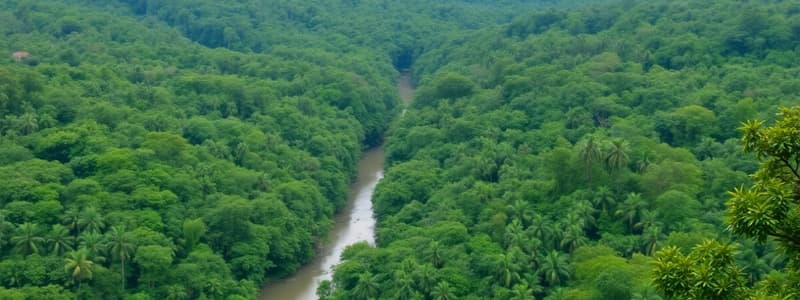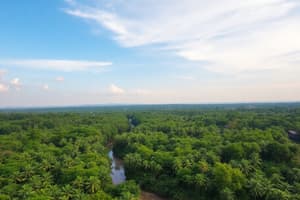Podcast
Questions and Answers
What is the main factor that influences the distribution of vegetation types in Australia?
What is the main factor that influences the distribution of vegetation types in Australia?
- The presence of rivers and lakes
- The latitude of the region
- The amount of annual precipitation (correct)
- The presence of mountain ranges
Which environmental factor is most responsible for the melting of glaciers in the Alps?
Which environmental factor is most responsible for the melting of glaciers in the Alps?
- Plate tectonics
- Volcanic activity
- Climate change (correct)
- Natural erosion
What is the main reason why most villages and towns are located in low-lying areas?
What is the main reason why most villages and towns are located in low-lying areas?
- Availability of fertile land
- Proximity to rivers and lakes
- Ease of transportation
- Favorable climatic conditions (correct)
In the context of Australia's land use, which one of these statements is most accurate?
In the context of Australia's land use, which one of these statements is most accurate?
What is the relationship between precipitation and the amount of animal life in a particular region?
What is the relationship between precipitation and the amount of animal life in a particular region?
Which type of vegetation would you expect to find in areas with an annual precipitation of 250-500 mm?
Which type of vegetation would you expect to find in areas with an annual precipitation of 250-500 mm?
What is the major challenge faced by the Inuit people living in the Arctic region?
What is the major challenge faced by the Inuit people living in the Arctic region?
What is the most notable characteristic of the Lötschental?
What is the most notable characteristic of the Lötschental?
Flashcards
Deforestation in the Amazon
Deforestation in the Amazon
The large-scale clearing of the Amazon rainforest negatively impacting biodiversity and climate.
Temperature in the Amazon
Temperature in the Amazon
Temperatures can reach around 18°C throughout the year due to its tropical climate.
Rainfall in the Amazon
Rainfall in the Amazon
The Amazon receives over 2000 mm of rain annually, supporting lush vegetation.
Savannah
Savannah
Signup and view all the flashcards
Precipitation zones in Australia
Precipitation zones in Australia
Signup and view all the flashcards
Inuit Living Conditions
Inuit Living Conditions
Signup and view all the flashcards
Global warming effects
Global warming effects
Signup and view all the flashcards
Tree line concept
Tree line concept
Signup and view all the flashcards
Study Notes
Knowledge and Skills for C2 Great Natural Landscapes on Earth
-
Study Tips:
- Summarize the provided information.
- Write everything out from the list, don't just summarize based on understanding.
- Memorize GeoGuide numbers.
- Practice notes and workbook assignments.
-
General Skills:
- Extract information from sources (figures, titles, axes, legends).
- Know the definitions of key terms in paragraphs (blue words).
- Link paragraphs to book numbers.
Paragraph 1: Deforestation in the Amazon
-
Natural vs. Cultural Landscapes:
- Natural landscapes haven't been changed by humans.
- Cultural landscapes have been altered by humans.
-
Tropical Rainforest Characteristics:
- Average temperature: 18°C year-round.
- Average precipitation: 2000 mm per year.
- Significant tree cover and high humidity.
-
Latitude and Temperature Relationship:
- Higher latitudes are colder than lower latitudes. This is due to the angle of the sun's rays hitting the Earth.
-
Tropical Rainforest Heat Explanation:
- The sun's angle is less oblique at the tropics, leading to less shadow and direct sunlight.
- Shorter travel distances for the sun's rays to reach the tropics compared to higher latitudes.
-
Tropical Rainforest Characteristics (5 Examples):
- Always warm temperature.
- High biodiversity.
- Trees reach high heights.
- Significant precipitation year-round.
- Dense vegetation.
Paragraph 2: The Australian Outback
- Outback Vegetation (Savanna, Steppes, Desert):
- Savanna: tall grasses and scattered trees.
- Steppes: short grasses and shrubs.
- Desert: very little vegetation due to low precipitation.
Paragraph 3: Inuit in the Arctic
-
Greenland Population Distribution:
- Coastal areas are inhabited due to the harsh climate of inland Greenland.
- Insufficient warmth for human settlement inland.
-
Greenland Tree Absence:
- Temperatures are too cold for most tree types.
-
Taiga Vegetation:
- Includes grasses, moss, and small shrubs (suitable for the cold).
-
Tundra's Summer Mashiness:
- Permafrost thawing in the summer results in a soggy, marshy environment.
-
Land Ice vs. Sea Ice:
- Land ice: thick layers of perpetual snow.
- Sea ice: frozen seawater.
-
Arctic Climate Change Consequences (2 Examples):
- Melting ice due to global warming.
- Shrinking ocean ice thickness.
Paragraph 4: The Lötschental
-
High Mountain Range Population Density:
- Low population density due to challenging terrain and weather.
-
Relief Influence on Settlement in Switzerland:
- People tend to settle in lower-lying areas.
Studying That Suits You
Use AI to generate personalized quizzes and flashcards to suit your learning preferences.




